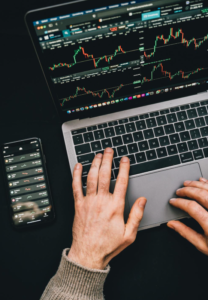The technological advancements of the last few years have brought radical changes. For example, there are over 409,000 public Wi-Fi hotspots across the US, from cafes to train stations. While this accessibility can be beneficial, it can also present added risk.
When you step into your local Starbucks for a cup of joe while you check your investments, you put yourself at risk. Cybercriminals could be lurking, ready to drain your funds.
Why is Protecting Your Financial Portfolio Important?
If your portfolio gets hacked, you could lose everything you’ve invested. So, using cybersecurity tools like a VPN or password manager can help prevent major losses. What does VPN mean, and what’s a password manager? In this article, we explain these and three other options to consider when addressing your cyber safety.
5 Online Tools For Portfolio Protection
There are many ways to approach managing your portfolio’s safety. Choosing the right tools and apps can make a tremendous difference. We’ve compiled a list of helpful programs, so you know what to look for.
Secure Trading Apps
Today, the finance world is in the palm of your hands. Trading apps offer efficiency and convenience at the push of a button. They also provide a variety of security features to protect your personal and financial data.
Robinhood is one of many secure trading platforms you can try. This app offers various security measures, from password hashing to TLS protocols.

VPN for Secure Connections
A VPN (Virtual Private Network) is an internet traffic and location encryption tool. Its key purpose is to ensure your internet privacy when using public networks. It does this by encrypting your internet usage.
VPNs like Surfshark hide your IP address and prevent tracking, putting a wall between you and anyone snooping or trying to steal your data.
Password Managers
When handling personal finance, a password manager is key. Financial portfolios are valuable, requiring a sturdy lock to secure them. Apps like LastPass can create and stow complex passwords. With a program like this, you reduce the risk of using weak or old passwords or forgetting strong ones.
Email Security Features
Many hacks have been caused by email phishing. It’s important to ensure your email provider protects you against it. Platforms such as Gmail offer sophisticated security features that cater to this need. These include showing warnings on emails, moving them to spam, and warning you if you click links to untrusted websites from suspicious emails.
However, relying solely on default settings may not be enough for businesses or individuals with more complex security needs. This is where professional assistance becomes valuable. Getting in touch with specialists offering IT Support For Derby, or in your local area, can help you implement additional email security measures tailored to your specific requirements. These experts can assist with configuring advanced spam filters, setting up multi-layered authentication protocols, and ensuring all users are trained to recognize phishing attempts, ultimately creating a safer digital environment.
Multi-Factor Authentication (MFA)
You have likely encountered the term 2FA (two-factor authentication); however, this is just one form of MFA that requires two or more layers of authentication. Adding extra verification methods like biometrics on top of a usual username and password.
An example of a tool that adds an extra authentication layer to help keep you protected is Google Authenticator. This app generates unique codes that you need to enter when logging on to a website you have linked with the tool.
Safeguard Your Financial Future
With rapid technological advancements comes a growing threat of cyber-attacks. It also introduces better methods to prevent them. So, get a head start by using the apps and tools mentioned above to help make your portfolio safer.
